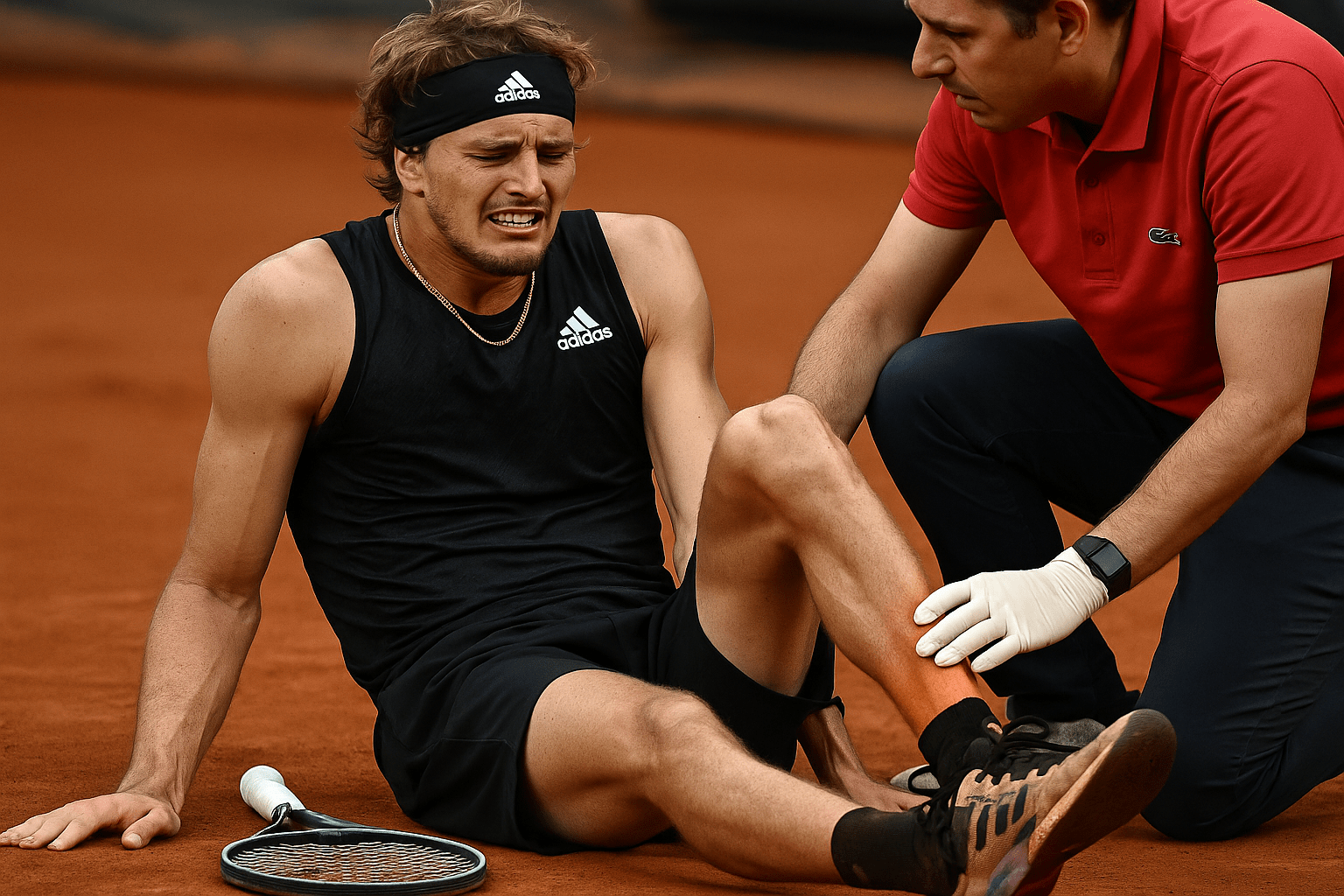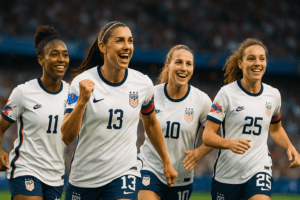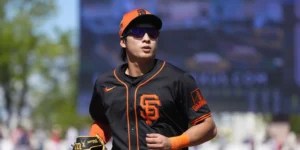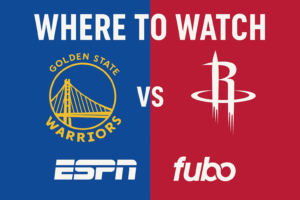In the world of tennis, moments of greatness are often one movement away from disaster. No example has captured that truth quite like the Zverev injury during the French Open. One wrong step on the red clay of Roland-Garros and everything changed. Alexander Zverev, one of the most consistent names in the top tier of the ATP, saw his ascent interrupted not by a formidable opponent, but by his own body.
The silence that followed his collapse on court was deafening. No line judge call, no crowd roar. Just the sound of a player in pain and a match that stopped mattering. When the news came that it was a serious ankle ligament injury, the entire tennis calendar felt a shift—a new hole carved in the heart of the tour. Tennis scores would move on without him, but they wouldn’t look the same.
A Match That Never Finished
The semifinal between Zverev and Nadal was supposed to be a classic. Long rallies. Brutal drop shots. Heavy topspin exchanges. For two sets, that’s exactly what the crowd got. Then, in a flash, Zverev slipped chasing a wide ball. His ankle twisted beneath him, and before the ball even bounced twice, he was down.
Tears. A wheelchair. An exit not made in defeat, but in distress. The scoreboard was abandoned. The match, unfinished. No amount of post-match coverage could really encapsulate the gravity of that moment. It wasn’t just a player losing a chance at a title. It was a professional life paused.
Tennis channel footage replayed the fall endlessly. But for those who watched live, it wasn’t about mechanics. It was about the look in Zverev’s eyes—one of disbelief, pain, and helplessness. The kind of moment that reminds you tennis isn’t just about elegance. It’s about endurance, and sometimes, about heartbreak.
What the Rankings Don’t Show
The ATP adjusted. Seedings reshuffled. Younger names broke through. But even as new faces began filling quarterfinals and headlines, the shadow of the Zverev injury lingered. Not because of nostalgia, but because of his presence. Zverev wasn’t just a name on a draw sheet. He was a disruptor of rhythm, a player capable of upsets and dominance alike.
Without him, the ecosystem of the tour changed. Tennis scores from tournaments like Madrid and Shanghai read differently. The balance shifted. Every big clash missing Zverev became a question left unanswered. Would those matches have played out the same way?
In a season where Djokovic and Alcaraz became the predictable top-line stories, the missing subplot was clear. Zverev was the wildcard that never entered the scene.
The Recovery Nobody Saw
Rehabilitation isn’t glamorous. It doesn’t come with stadium noise or sponsor lights. For Zverev, the months that followed were marked by silent training facilities, countless hours with physiotherapists, and mental battles far more challenging than a five-set match.
He began posting occasional videos: stretching drills, light jogs, slow-motion practice swings. Fans clung to every clip. But there was no timeline. No promises. Just the slow return of someone trying to piece back the layers of a top-tier tennis player.
Media outlets were cautious. Tennis news turned to speculation: Would he be ready for the US Open? Could he make the ATP Finals? Most headlines danced around certainty. What no one could confirm was the truth Zverev himself understood—the physical part heals fastest. It’s trust in the body that takes longer.
The Return: Not Quite the Same, Not Entirely Different
When Zverev stepped back onto court for the first time after the injury, it was an early-round match in a smaller tournament. But to those watching, it felt like a final. Each step he took was watched closely. Would he hesitate? Would he slide on hardcourt? Would he play like he trusted his ankle?
The match didn’t go flawlessly. He dropped a set. He missed routine shots. But he didn’t stop moving. That mattered more than the tennis scores. What was on display wasn’t peak form. It was persistence. A tennis player refusing to let one moment define a career.
Over the next few months, he gathered momentum. Nothing spectacular, but enough to return to the conversation. A top 20 win here. A deep run there. The fans began to believe again. So did the broadcasters. Even the tennis channel segments changed tone—from cautious monitoring to cautious optimism.
A Changed Rivalry Landscape
The injury didn’t just stall Zverev’s rise. It reshaped others’. Rivals like Tsitsipas and Medvedev adjusted their expectations. What would have been tightly contested showdowns often turned into uncontested runs. A match between Zverev and Alcaraz never materialized that year. That absence created gaps in both narrative and performance.
As each Grand Slam passed, the draw sheets highlighted the absence. Zverev wasn’t just missing matches. He was missing moments. And the game missed him back. Tennis thrives on rivalries. The Zverev injury paused some, ended others, and delayed new ones from forming.
More Than Numbers: The Human Angle
Behind the data, the ATP points, and the rankings lives the reality of sport that fans rarely witness: identity. For Zverev, being a tennis player wasn’t a job. It was a state of being. Having that stripped away for months was a deeper loss than any set or title.
Interviews post-return showed it. His language was different. Less bravado. More reflection. Less talk about titles. More about time.
One segment on tennis channel featured a quiet, seated Zverev discussing the injury with surprising openness. He didn’t dramatize it. He didn’t downplay it. He simply said, “You don’t know what you need until it’s not there.”
What Comes Next?
Zverev’s game is returning. Slowly. His serve is back to pace. His baseline movement looks sharper. He’s winning longer rallies. The confidence isn’t fully restored, but it’s coming.
What fans want to know now isn’t whether he can win again—that answer is yes. The real question is whether he can stay. The Zverev injury was a reminder that greatness requires not just skill but survival.
Future matchups with Sinner, Rune, and even a rematch with Nadal now carry new weight. They’re not just about wins. They’re about legacy recovery.
Closing Thoughts: The Game, Interrupted
Tennis is cruel that way. It doesn’t wait. The calendar turns, the next set begins. But every now and then, a story cuts through the rotation. The Zverev injury did that. It showed the fragility behind the fight, the silence behind the serve.
Now, as Zverev grinds back into form, every point feels a little different. Not just because of what’s ahead. But because of what he already made it through.
His journey, more than anything, is a reminder that in this game, resilience is as important as talent. And some of the best comebacks don’t start with a trophy. They start with a limp. Then a walk. Then a sprint.
And before you know it, a tennis player becomes more than a name in the rankings. They become the story itself.




